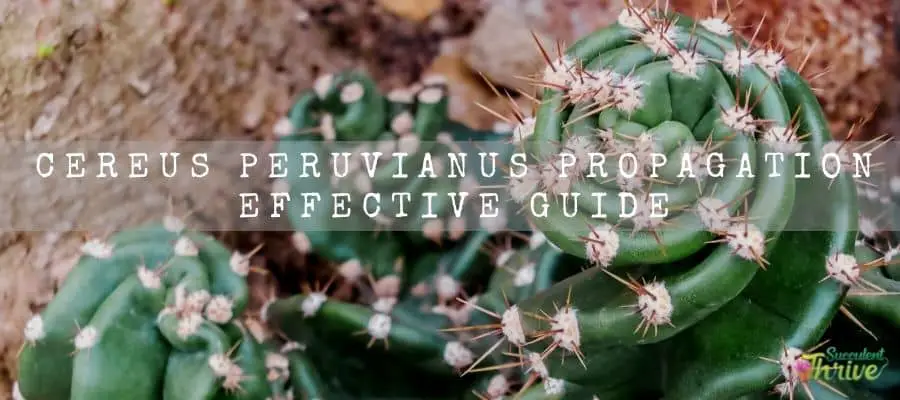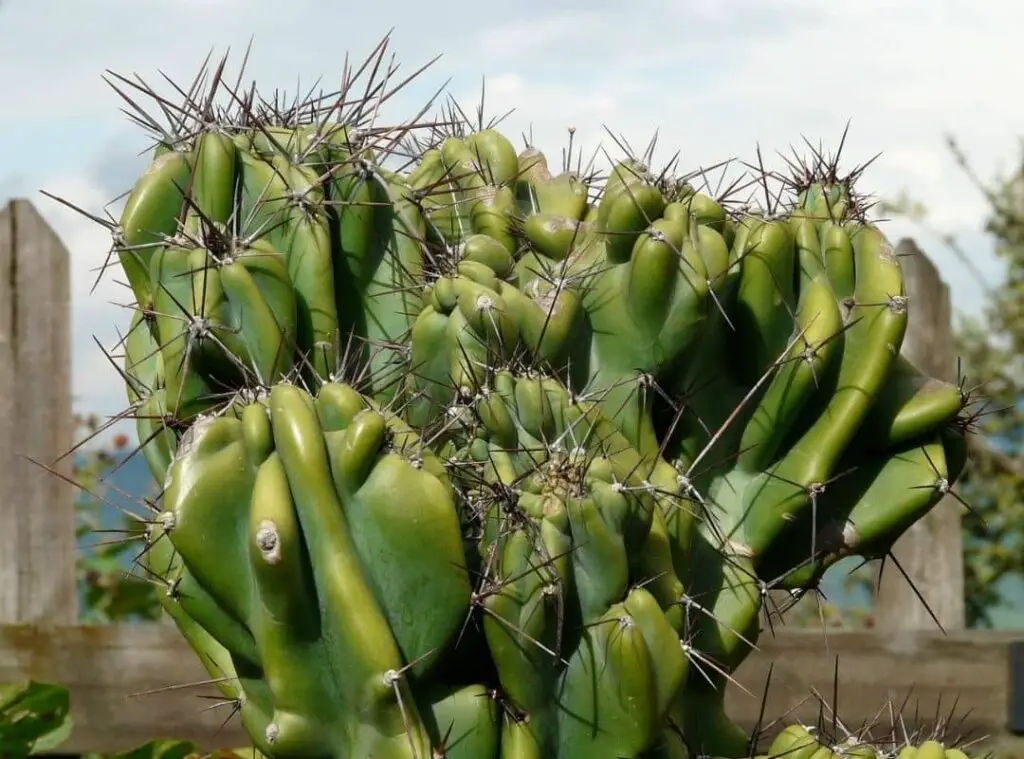Cereus peruvianus propagation could be done using their cuttings, seeds and in applying the division method.
Cereus peruvianus are beautiful sets of plants which go by the common name called Peruvian apple cactus.
Cereus peruvianus are native to South America. These plants would rise to a maximum height of 10m ( 33 feet ) and a maximum width of 20 cm ( 8 inches ) in diameter.
In terms of their appearances, they would produce flowers in white colors. Further they would consist of red tips as well.
These plants would usually grow like trees, and they would tend to take the shape of a multi branched candlestick.
You could spot the Cereus peruvianus individual stems in gray blue to gray green colors. Further those stem ribs may contain a twisted wavy pattern too.
It would give a unique appearance. Cereus peruvianus would usually grow slowly and in a much more compact manner.

Cereus peruvianus propagation by cutting?
You could use the stem cuttings to propagate the Cereus peruvianus as aforesaid.
First you need to select a mature plant which has several stem extensions from the main stem.
Once you make the cutting, you need to make it on the top side of the stem which you are using for the propagation process.
Before that keep in mind that the tools you use for this purpose should be all sterile. That way you can be assured that there will be no infection.
Once you obtain the cuttings, you need to keep them somewhere where they can wither for about two weeks’ time. During this time, they would develop callousness.
After that you need to observe the cutting well and insert them in a well-draining soil mix.
Once you plant them, you need to ensure that you do not supply them with water in excess. If you do so, it will lead to unnecessary infections in the specimen.
When the roots are well established and developed, you can transplant them in individual pots. Ensure that you expose them to specimen bright indirect sunlight without exposing them to direct sunlight at once.
Do they produce seeds?
Cereus peruvianus plants produce seeds and you can use them for propagation as well.
However, the seed prorogation method is somewhat slow when compared to the rest of other propagation methods.
Having said that, you could germinate their seeds and spot them becoming matured plants from the initial stage itself. However, it would be a challenging task and time consuming too.
Do they produce offsets?
Cereus peruvianus produce offshoots and you may conduct their propagation using the offsets as well.
They would adapt faster and have a high potential of succeeding as well. However, they have to be mature enough to produce offshoots and they would take some time for that.
When you spot them producing offshoots, you can simply obtain a sharp knife and remove them from the main plant.
Once you remove it, clean the older soil around the plants. Next leave them somewhere in a place where they will be at room temperature and then plant them in an appropriate soil mix.
Once their soil is dry, you need to resume watering them.

How to treat after propagation
Light requirement
Cereus peruvianus performs well with a lot of sunlight. Hence you need to keep them in a place where they can gain ample sunlight.
Thus, I recommend placing them near a bright sunny windowsill if you wish to keep them indoors.
However, I recommend exposing them for bright indirect sunlight and not under direct sunlight right after you propagate them.
During winter, I suggest placing artificial lights closer to the plants so that it would further fulfill the light requirement of the plants.
Someone might find that option as costly, but it would be a great investment since it would reduce the variations in the light intensity once the seasons change.
Soil requirement
It is crucial that you provide a soil mix which has excellent drainage to grow the Cereus peruvianus plants.
It has to be ideally a sandy soil mix which has a ph. range of 5-7. If you wish to check the ph. level of the soil mix, you may simply use a good soil pH kit and then check.
If not, you could simply take a sample of soil to the lab and then check too. As aforesaid , you may consider adding sand to enhance the draining of the soil mix.
Ideally you need to mimic the same conditions they get in their natural habitat when you cultivate them too.
Watering requirement
Cereus peruvianus plants are the type of plants which would thrive well with minimum watering.
They are very well adapted to grow in areas where there are minimal watering levels. Besides they have leaves which have conserved water and that characteristic makes them thrive in drought conditions for longer periods.
Furthermore, you need to water them actively during spring and summer whilst ensuring that you allow their soil to wither between two watering sessions. That way you could avoid over watering which would result in root rot at the end.
You need to minimize watering them during winter as it would be the biggest mistake you could commit when taking care of them in winter.
Excess water would result in health deterioration of the plants and make them more vulnerable for other bacterial and fungal infections as well.
So, to properly water them, you need to always check the soil condition first. To do that you could simply place the finger in the soil for about two inches and check whether you could feel any moisture there.
If you find any moisture in the soil, it literally means the plants do not require any more water. Further, you need to adjust watering them depending on the season as well.
When you water, you simply have to sprinkle some water sparingly on the soil layer. Further you need to adjust the watering depending on the pot size and on the plant size as well.
Literally the larger pots may retain more water within, and you need to water them less for those.
Besides when you finish watering them, you need to ensure that you let the excess water move away too. Best is to water them once every week or once every ten days.
Temperature and humidity care
Cereus peruvianus plants perform well given that they get warmer temperatures right throughout.
Additionally, they need to have low humidity levels too. The optimal temperature which would suit them would be above 70 degrees Fahrenheit.
Further they are somewhat cold and hardy up to 25 degrees Fahrenheit. However, I still suggest you bring them indoors as if the temperature further decreases, it would result in adverse repercussions on the plants health.
Pot requirement
Best is to use a pot which has ample draining to grow the Cereus peruvianus plants.
In addition to that I recommend growing them in porous material such as clay or terracotta so that they would evaporate the excess water faster.
Fertilizer requirement
Cereus peruvianus plants usually grow in fertile soil mixes when they grow in the wild.
Hence you can limit feeding them. However, it is always best to feed them during their active growing season so that it would stimulate the healthy growth of the plants.
I recommend feeding them with a cactus fertilizer which has Nitrogen, Potassium and phosphorus.
To further elaborate on this, Nitrogen stimulates the growth of the leaves, stem and rest of other parts of the plants.
In addition to that Phosphorus is crucial for root growth and for seed germination as well. Finally, potassium is crucial for flowering and for fruit development as well.
I recommend feeding them in spring and in summer.
Conclusion
Propagating the Cereus peruvianus plants is quite easy if you ensure that you practice the right steps.
Further, keep in mind that you need to practice the aforesaid tips so that you could get the best results of the propagation.
Read Next : Fairy Castle Cactus Propagation | An Effective Guide | When To Propagate Christmas Cactus?
